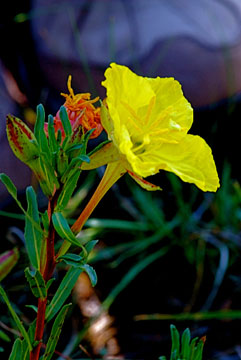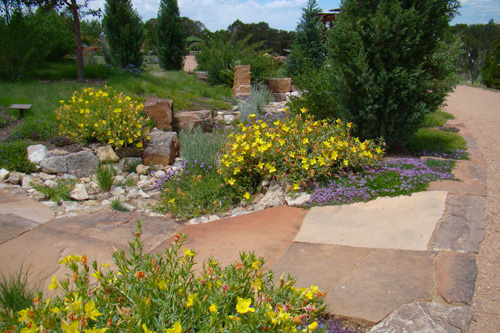Scientific name: Oenothera hartwegii subsp. fendleri

Oenothera hartwegii subsp. fendleri (Photo by Janice Tucker)
Synonym: Calylophus serrulatus
Family: Onagraceae (Evening Primrose)
Common names Fendler’s sundrops, sundrops
Article by Susan Bruneni
Sundrops are unique members of the evening primrose family (Onagraceae). They are a few of the more than 145 species that open blooms during the heat of the day. Others open their blooms in cooler times of day. Sundrops are noticeable along roadsides south of Santa Fe as 12-to-18-inch bushy plants covered with yellow blooms. The USDA terms them “subshrubs”. They are eagerly devoured by livestock and do not re-grow quickly on over-grazed lands. A similar species, Calylophus hartwegii (Hartweg’s sundrop) is growing at Museum Hill.
Oenothera hartwegii subsp. fendleri is a perennial herb with alternate oblong leaves and vivid yellow flowers. When the flowers begin to wilt they turn an orangish-red. The stems are woody. Blossoms have four petals emerging from a long tube and are two-to-three inches in diameter. Petals have a unique “crinkled” appearance.
They are found in Texas, Oklahoma, Kansas, New Mexico, and Arizona. They are particularly striking at locations in these states such as national parks and near Carlsbad Caverns, where lands are not grazed and they can flourish.
A number of subspecies are available from growers. Advantages are: drought tolerance, full sun in hot and dry areas, low water and does well in clay, sandy, caliche and poor soils. Blooms late spring through summer, depending on water availability. Sundrops are currently in bloom at both SFBG sites.
The name Hartwegii is derived from Karl Theodor Hartweg (1812-1871), a German botanist. Hartweg was hired by the London Horticultural Society Gardens to collect plants and seeds in North and Central America. The hunt for new plants was commercially driven. Rare exotic plants from the New World were fueling a lucrative business in Europe.
On his first trip (1836-1840) Hartweg literally walked from one side of Mexico to the other, seeking remote areas with exotic plant life, and journeyed south as far as Peru and east to Jamaica. Vera Cruz (Mexico) became the mecca for European botanists on similar commercial ventures. Hartweg commented to one of his contemporaries, “all the way from London just to look after weeds”.
On his second trip (1845-46) Hartweg sailed from Vera Cruz to California and collected seeds and specimens, including sundrops.
References:

Sundrops along Meadow Garden Walkway and Central Walkway in Orchard Gardens on Museum Hill (by Clayton Bass)


